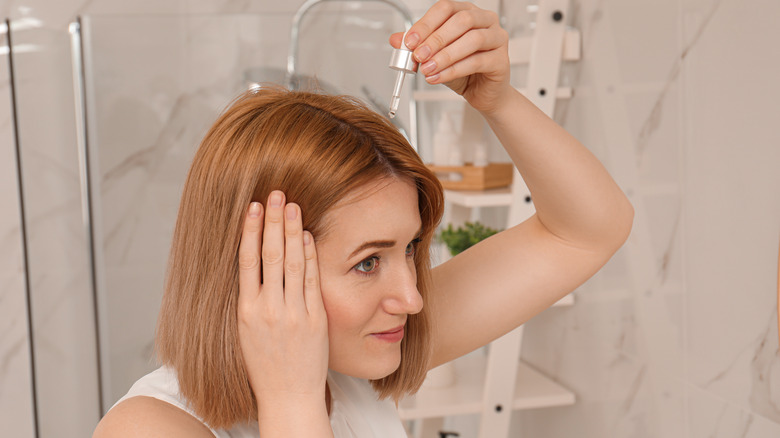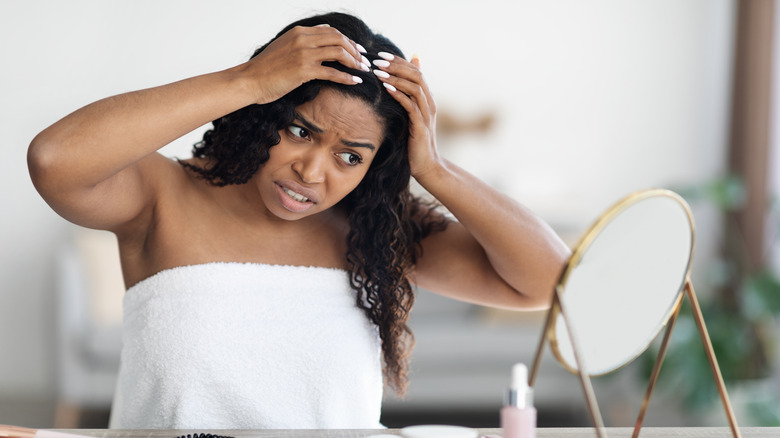Does Tretinoin Belong In Your Haircare Routine Too?
Hair shedding, breakage, and loss aren't easy things to deal with. There are DIY hair loss treatments like onion juice, but results are often slow to appear. And hiding the issue with extensions can make matters worse. Rumor has it that tretinoin can put those worries to bed.
Tretinoin is a retinol typically used to combat acne. But people on social media are moving it from their skincare routine to their haircare regime. It is not the first time an ingredient has worked a double shift for your skin and hair. Coconut oil delivers protein to damaged hair and moisturizes dry skin. Shea butter's anti-inflammatory properties fight scarring while its fatty acids condition limp strands. Now tretinoin seeks to join the dual beauty benefits crew.
If you have some tretinoin cream sitting around from days of rough puberty, it might be time to put it to good use again — in a new way. But before slathering acne gel to thinning hair and bald spots, let's see what the science says.
Tretinoin may be the answer for reversing hair loss
Tretinoin is a retinol medicine that increases skin cell turnover rates. In other words, it creates newer and healthier cells. Although usually used to treat acne, research shows that tretinoin helps to promote hair development when paired with other growth treatments. A 2019 study published in Dermatologic Therapy found that patients who suffered from alopecia had an increased response to the hair regrowth medicine minoxidil after using tretinoin for five days. Approximately 43% of subjects who saw no reaction to minoxidil became responsive to the medicine after applying topical tretinoin.
Dr. Wendy Roberts, a haircare expert and dermatologist, tells Coveteur, "Retinol can increase the penetration of other products, especially in the area of hair loss, where we are trying to get products down the follicle to stimulate new hair growth." This reaction explains why tretinoin boosts the power of minoxidil.
Tretinoin is FDA-approved for treating acne and symptoms of photoaging, like wrinkles and hyperpigmentation. There is also a record of FDA off-label uses for topical tretinoin, such as managing psoriasis and early stretch marks. However, this vitamin A derivative is not approved as a remedy for hair loss, on- or off-label. But don't lose hope. There are several proven methods for stimulating hair regrowth.
Tried and true methods for hair regrowth
Adding tretinoin to your skincare routine is a better bet than using it alone to promote hair growth. However, it does allow other growth treatments to work more effectively. For optimal results, it should be used to boost another hair treatment and improve scalp health but not as a standalone regrowth serum.
Minoxidil is the most popular FDA-approved hair regrowth product on the market. It is better known by its commercial name, Rogaine. It can stimulate growth and slow the rate of hair loss. This treatment comes in foam, liquid, and as a shampoo. Spironolactone is another option. A 2015 study published in the Journal of the American Academy of Dermatology found almost 75% of subjects who used spironolactone noticed an improvement in their regrowth. However, it is also used to lower high blood pressure and can be dangerous if overused.
Hair loss happens for a variety of reasons, from hormones to stress. It is best to consult your doctor about which treatment is right for you. And, who knows, it might benefit from a tretinoin boost.

